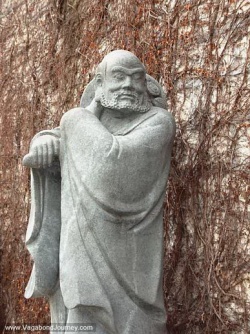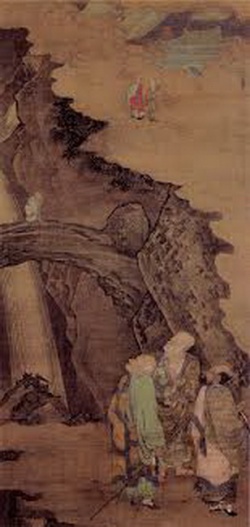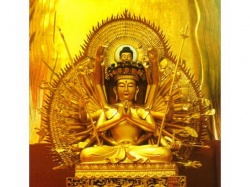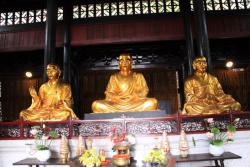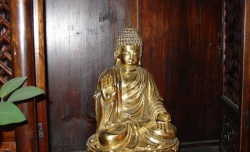Difference between revisions of "Tiantai School"
(Created page with "thumb|250px| <poem> Tiantai (Chinese and Japanese: 天台宗; pinyin: tiāntāi zōng; ) is an important school of Buddhism in China, Japan, Korea, ...") |
|||
| Line 1: | Line 1: | ||
[[File:ChinaTiantai.JPG|thumb|250px|]] | [[File:ChinaTiantai.JPG|thumb|250px|]] | ||
<poem> | <poem> | ||
| − | Tiantai (Chinese and Japanese: 天台宗; pinyin: tiāntāi zōng; ) is an important school of Buddhism in China, Japan, Korea, and Vietnam. In Japan the school is known as Tendai-shū, and in Korea it is known as Cheontae. | + | [[Tiantai]] (Chinese and Japanese: 天台宗; pinyin: tiāntāi zōng; ) is an important school of [[Buddhism in China]], [[Japan]], [[Korea]], and [[Vietnam]]. In [[Japan]] the school is known as [[Tendai]]-shū, and in [[Korea]] it is known as Cheontae. |
| − | The name is derived from the fact that Chih-i, the fourth | + | The name is derived from the fact that Chih-i, the fourth [[Patriarch]], lived on Mount [[Tiantai]].[[Tiantai]] is sometimes also called "The [[Lotus]] School", after the central role of the [[Lotus Sutra]] in its teachings. |
| − | During the Tang Dynasty, the Tiantai school became one of the leading schools of Chinese Buddhism, with numerous large temples supported by emperors and wealthy patrons, with many thousands of | + | During the Tang Dynasty, the [[Tiantai]] school became one of the leading schools of [[Chinese Buddhism]], with numerous large temples supported by emperors and wealthy patrons, with many thousands of [[Monks]] and millions of followers. |
History | History | ||
| − | The | + | The [[Bodhisattva]] [[Avalokiteśvara]], an important figure from the [[Lotus]] [[Sūtra]]. |
| − | Most scholars regard the Tiantai as one of the first truly Chinese schools of Buddhist | + | Most scholars regard the [[Tiantai]] as one of the first truly Chinese schools of Buddhist [[Thought]]. The [[Schools of Buddhism]] that had existed in China prior to the emergence of the [[Tiantai]] are generally believed to represent direct transplantations from [[India]], with little modification to their basic doctrines and methods. The creation of the [[Tiantai]] school signified the maturation and integration of [[Buddhism]] in the Chinese context. No longer content to simply translate texts received from Indian sources, Chinese Buddhists began to apply new analyses to old texts, and even to produce new scriptures and commentaries that would attain significant status within the East Asian sphere. |
| − | The Tiantai school became doctrinally broad, able to absorb and give rise to other movements within Buddhism. The tradition emphasized both scriptural study and | + | The [[Tiantai]] school became doctrinally broad, able to absorb and give rise to other movements within [[Buddhism]]. The tradition emphasized both scriptural study and [[Meditative]] practice, and taught the rapid [[Attainment of Buddhahood]] through observing the [[Mind]]. |
[[File:Iantai2.jpg|thumb|250px|]] | [[File:Iantai2.jpg|thumb|250px|]] | ||
| − | The school is largely based on the teachings of Zhiyi, Zhanran, and Zhili, who lived between the 6th and 11th centuries in China. These teachers took an approach called "classification of teaching" in an attempt to harmonize the numerous and often contradictory Buddhist texts that had come into China. This was achieved through a particular interpretation of the Lotus Sūtra. | + | The school is largely based on the teachings of [[Zhiyi]], Zhanran, and Zhili, who lived between the 6th and 11th centuries in China. These teachers took an approach called "classification of teaching" in an attempt to harmonize the numerous and often contradictory [[Buddhist texts]] that had come into China. This was achieved through a particular interpretation of the [[Lotus]] [[Sūtra]]. |
Patriarchs | Patriarchs | ||
| − | Due to the use of Nāgārjuna's philosophy of the Middle Way, Nagarjuna is traditionally taken to be the first | + | Due to the use of [[Nāgārjuna]]'s philosophy of the [[Middle Way]], [[Nagarjuna]] is traditionally taken to be the first [[Patriarch]] of the [[Tiantai]] school. |
| − | The sixth century | + | The sixth century [[Dhyāna]] master Huiwen (慧文) is traditionally considered to be the second [[Patriarch]] of the [[Tiantai]] school. Huiwen studied the works of [[Nāgārjuna]], and is said to have [[Awakened]] to the profound meaning of [[Nāgārjuna]]'s words: "All conditioned [[Phenomena]] I speak of as empty, and are but false names which also indicate the mean." |
| − | Huiwen later transmitted his teachings to the | + | Huiwen later transmitted his teachings to the [[Dhyāna]] master Huisi (Ch. 慧思, 515-577 CE), who is traditionally figured as the third [[Patriarch]]. During [[Meditation]], he is said to have realized the [[Lotus]] [[Samādhi]], indicating [[Enlightenment]] and [[Buddhahood]]. He authored the text [[Mahāyāna]]-śamatha-vipaśyanā. |
| − | Venerable Huisi then transmitted his teachings to Śramaṇa Zhiyi (Ch. 智顗, 538-597 CE), who is traditionally figured as the fourth | + | [[Venerable]] Huisi then transmitted his teachings to Śramaṇa [[Zhiyi]] (Ch. 智顗, 538-597 CE), who is traditionally figured as the fourth [[Patriarch]] of [[Tiantai]], who is said to have practiced the [[Lotus]] [[Samādhi]] and to have become [[Enlightened]] quickly. He authored many treatises such as explanations of the [[Buddhist texts]], and especially systematic manuals of various lengths which explain and enumerate methods of Buddhist practice and [[Meditation]]. The above lineage was proposed by Buddhists of later times and do not reflect the popularity of the [[Monks]] at that time. |
| − | Zhiyi | + | [[Zhiyi]] |
| − | Most scholars consider Zhiyi to have been the major founder of the Tiantai school, since he did the most to systematize and popularize the doctrines and methods associated with it. At a later date, the school's sixth | + | Most scholars consider [[Zhiyi]] to have been the major founder of the [[Tiantai]] school, since he did the most to systematize and popularize the doctrines and methods associated with it. At a later date, the school's sixth [[Patriarch]], Zhanran, would compose clarifying commentaries on [[Zhiyi]]'s writings. |
[[File:Tiantai-s.jpg|thumb|250px|]] | [[File:Tiantai-s.jpg|thumb|250px|]] | ||
| − | Zhiyi analyzed and organized all the Āgamas and Mahayana | + | [[Zhiyi]] analyzed and organized all the Āgamas and [[Mahayana]] [[Sutras]] into a system of [[Five periods]] and eight types of teachings. For example, many elementary doctrines and bridging concepts had been taught early in [[The Buddha]]'s advent when the vast majority of the people during his time were not yet ready to grasp the 'ultimate [[Truth]]'. These teachings (the Āgamas) were an upaya, or skillful means, were simply an example of [[The Buddha]] employing his boundless [[Wisdom]] to lead those people towards the [[Truth]]. Subsequent teachings delivered to more advanced followers thus represent a more complete and accurate picture of [[The Buddha]]'s teachings, and did away with some of the philosophical 'crutches' introduced earlier. [[Zhiyi]]'s classification culminated with the [[Lotus Sutra]], which he held to be the supreme synthesis of Buddhist [[Doctrine]]. The difference on [[Zhiyi]]'s explanation to the [[Golden Light Sutra]] caused a debate in Song Dynasty. |
Texts | Texts | ||
| − | The Tiantai school takes the Lotus Sūtra (Saddharmapuṇḍarīka Sūtra) as the main basis, the | + | The [[Tiantai]] school takes the [[Lotus]] [[Sūtra]] (Saddharmapuṇḍarīka [[Sūtra]]) as the main basis, the Mahā[[Prajñā]]pāramitā Śāstra of [[Nāgārjuna]] as the guide, the [[Nirvāṇa]] [[Sūtra]] as the support, and the Pañcaviṃśatisāhasrikā [[Prajñā]]pāramitā [[Sūtra]] for methods of contemplation. |
| − | In addition to its doctrinal basis in Indian Buddhist texts, the Tiantai school also emphasizes use of its own | + | In addition to its doctrinal basis in Indian [[Buddhist texts]], the [[Tiantai]] school also emphasizes use of its own [[Meditation]] texts which emphasize the principles of śamatha and vipaśyanā. Of the [[Tiantai]] [[Meditation]] treatises, [[Zhiyi]]'s Concise Śamatha-vipaśyanā (小止観), Mahā-śamatha-vipaśyanā (摩訶止観), and Six Subtle [[Dharma]] Gates (六妙法門) are the most widely read in China.[5] Rujun Wu identifies the work Mahā-śamatha-vipaśyanā of [[Zhiyi]] as the seminal [[Meditation]] text of the [[Tiantai]] school. |
Classification of teachings | Classification of teachings | ||
| − | Tiantai classified | + | [[Tiantai]] classified [[The Buddha]]'s teachings in [[Five periods]] and [[Eight teachings]]. This classification is usually attributed to Chih-i, but is probably a later development. The classification of teachings was also done by other schools, such as the Fivefold Classification of the [[Huayan school]]. |
| − | Five | + | [[Five periods]] |
| − | The Five | + | The [[Five periods]] are [[Five periods]] in the [[LIFE OF THE BUDDHA]] in which he delivered different teachings, aimed at different audiences with a different level of understanding: |
[[File:Tiantai.jpg|thumb|250px|]] | [[File:Tiantai.jpg|thumb|250px|]] | ||
| − | The Period of Avatamsaka. During twenty-one days after his Enlightenment, | + | The Period of Avatamsaka. During twenty-one days after his [[Enlightenment]], [[The Buddha]] delivered the Avatamsaka [[Sutra]]. |
| − | The Period of Agamas. During twelve years, | + | The Period of Agamas. During twelve years, [[The Buddha]] preached the Agamas for the Nihayana, including [[The Four Noble Truths]] and [[Dependent origination]]. |
| − | The Period of Vaipulya. During eight years, | + | The Period of Vaipulya. During eight years, [[The Buddha]] delivered the [[Mahayana]] teachings, such as the [[Vimalakirti Sutra]], the Śrīmā[[L]]ādevī [[Sūtra]], the Suvarnaprabhasa [[Sutra]] and other [[Mahayana]] [[Sutras]]. |
| − | The Period of Prajna. During twenty-two years, | + | The Period of [[Prajna]]. During twenty-two years, [[The Buddha]] explained [[Emptiness]] in the [[Prajnaparamita]]-[[Sutras]]. |
| − | The Period of Dharma-pundarik and Nirvana. In the last eight years, | + | The Period of [[Dharma]]-pundarik and [[Nirvana]]. In the last eight years, [[The Buddha]] preached the [[Doctrine]] of the One [[Buddha Vehicle]], and delivered the [[Lotus Sutra]] and the [[Nirvana]] [[Sutra]] just before his [[Death]]. |
| − | Eight | + | [[Eight teachings]] |
| − | The Eight | + | The [[Eight teachings]] consist of the Four Doctrines, and the Fourfold Methods. |
Four Doctrines | Four Doctrines | ||
| − | Tripitaka Teaching: the Sutra, Vinaya and | + | [[Tripitaka]] Teaching: the [[Sutra]], [[Vinaya]] and [[ABHIDHAMMA]], in which the basic teachings are explained |
| − | Shared Teaching: the teaching of | + | Shared Teaching: the teaching of [[Emptiness]] |
| − | Distinctive Teaching: aimed at the Bodhisattva | + | Distinctive Teaching: aimed at the [[Bodhisattva]] |
| − | Perfect Teaching - the Chinese teachings of the Lotus Sutra and the Avatamsaka Sutra | + | Perfect Teaching - the Chinese teachings of the [[Lotus Sutra]] and the Avatamsaka [[Sutra]] |
Fourfold Methods | Fourfold Methods | ||
| Line 68: | Line 68: | ||
David Chappell lists the most important teachings as the doctrines of: | David Chappell lists the most important teachings as the doctrines of: | ||
| − | The Threefold Truth, | + | The Threefold [[Truth]], |
The Threefold Contemplation, | The Threefold Contemplation, | ||
The Fourfold Teachings, | The Fourfold Teachings, | ||
| − | The Subtle Dharma, | + | The Subtle [[Dharma]], |
The Nonconceivable Discernment. | The Nonconceivable Discernment. | ||
| − | Nan Huaijin, a 20th-century Chán-teacher, summarizes the main teaching of the Tiantai school as the following: | + | Nan Huaijin, a 20th-century [[Chán]]-teacher, summarizes the main teaching of the [[Tiantai]] school as the following: |
The One Vehicle (Skt. Ekayāna), | The One Vehicle (Skt. Ekayāna), | ||
| − | The vehicle of attaining Buddhahood, as the main principle; | + | The vehicle of attaining [[Buddhahood]], as the main principle; |
| − | The three forms of śamatha-vipaśyanā correlated with the | + | The three forms of śamatha-vipaśyanā correlated with the [[Meditative]] perspectives of [[Emptiness]], |
The mean, as the method of cultivating realization. | The mean, as the method of cultivating realization. | ||
| − | The Threefold Truth | + | The Threefold [[Truth]] |
| − | The Tiantai school took up the principle of The Threefold Truth, derived from Nāgārjuna: | + | The [[Tiantai]] school took up the principle of The Threefold [[Truth]], derived from [[Nāgārjuna]]: |
[[File:Tiantai0045.jpg|thumb|250px|]] | [[File:Tiantai0045.jpg|thumb|250px|]] | ||
| − | Phenomena are empty of self-nature, | + | [[Phenomena]] are empty of self-nature, |
| − | Phenomena exist provisionally from a worldly perspective, | + | [[Phenomena]] exist provisionally from a worldly perspective, |
| − | Phenomena are both empty of existence and exist provisionally at once. | + | [[Phenomena]] are both empty of existence and exist provisionally at once. |
| − | The transient | + | The transient [[World]] of [[Phenomena]] is thus seen as one with the unchanging, undifferentiated substratum of existence. This [[Doctrine]] of interpenetration is reflected in the [[Tiantai]] teaching of three thousand realms in a single moment of [[Thought]]. |
| − | The Threefold Truth has its basis in Nāgārjuna: | + | The Threefold [[Truth]] has its basis in [[Nāgārjuna]]: |
All things arise through causes and conditions. | All things arise through causes and conditions. | ||
| − | That I declare as | + | That I declare as [[Emptiness]]. |
It is also a provisional designation. | It is also a provisional designation. | ||
| − | It is also the meaning of the Middle Path. | + | It is also the meaning of the Middle [[Path]]. |
Three Contemplations | Three Contemplations | ||
| Line 103: | Line 103: | ||
While the Three Truths are essentially one, they may be recognized separately as one undertakes the Three Contemplations: | While the Three Truths are essentially one, they may be recognized separately as one undertakes the Three Contemplations: | ||
| − | The first contemplation involves moving from the | + | The first contemplation involves moving from the [[World]] of provisionality to the [[World]] of [[Emptiness]], or [[Shunyata]]. |
| − | The second contemplation is moving back from the | + | The second contemplation is moving back from the [[World]] of [[Emptiness]] to the [[World]] of provisionality with an acceptance thereof. |
| − | The third contemplation involves balancing the previous two by following the Middle Path. | + | The third contemplation involves balancing the previous two by following the Middle [[Path]]. |
The Fourfold Teachings | The Fourfold Teachings | ||
| + | [[Category:Es a.jpg]] | ||
| + | The Three Contemplations and Threefold [[Truth]] in turn [[Form]] the basis of the Fourfold Teachings, making them "parallel structures". | ||
| + | [[Meditation]]-practice | ||
| − | + | According to Charles Luk, in China it has been traditionally held that the [[Meditation]] methods of the [[Tiantai]] are the most systematic and comprehensive of all. [[Tiantai]] emphasizes śamatha and vipaśyanā [[Meditation]]. | |
| − | Meditation | ||
| − | + | Regarding the functions of śamatha and vipaśyanā in [[Meditation]], [[Zhiyi]] writes in his work Concise Śamatha-vipaśyanā: | |
| − | + | The attainment of [[Nirvāṇa]] is realizable by many methods whose essentials do not go beyond the practice of śamatha and vipaśyanā. Śamatha is the first step to untie all bonds and vipaśyanā is essential to root out [[Delusion]]. Śamatha provides nourishment for the preservation of the knowing [[Mind]], and vipaśyanā is the skillful [[Art]] of promoting [[Spiritual]] understanding. Śamatha is the unsurpassed cause of [[Samādhi]], while vipaśyanā begets [[Wisdom]]. | |
| − | + | The [[Tiantai]] school also places a great emphasis on [[Mindfulness]] of Breathing (Skt. ānāpānasmṛti) in accordance with the principles of śamatha and vipaśyanā. [[Zhiyi]] classifies breathing into four main categories: | |
| − | |||
| − | The Tiantai school also places a great emphasis on Mindfulness of Breathing (Skt. ānāpānasmṛti) in accordance with the principles of śamatha and vipaśyanā. Zhiyi classifies breathing into four main categories: | ||
Panting (喘), | Panting (喘), | ||
| Line 125: | Line 125: | ||
Stillness or rest (息). | Stillness or rest (息). | ||
| − | Zhiyi holds that the first three kinds of breathing are incorrect, while the fourth is correct, and that the breathing should reach stillness and rest. | + | [[Zhiyi]] holds that the first three kinds of breathing are incorrect, while the fourth is correct, and that the breathing should reach stillness and rest. |
Influence | Influence | ||
| − | David Chappell writes that although the Tiantai school, "has the reputation of being...the most comprehensive and diversified school of Chinese Buddhism, it is almost unknown in the West" despite having a "religious framework that seemed suited to adapt to other cultures, to evolve new practices, and to universalize Buddhism". He attributes this failure of expansion to the school having "narrowed its practice to a small number of | + | David Chappell writes that although the [[Tiantai]] school, "has the reputation of being...the most comprehensive and diversified school of [[Chinese Buddhism]], it is almost unknown in the West" despite having a "religious framework that seemed suited to adapt to other cultures, to evolve new practices, and to universalize [[Buddhism]]". He attributes this failure of expansion to the school having "narrowed its practice to a small number of [[Rituals]]" and because it has "neglected the [[Intellectual]] breadth and subtlety of its founder". |
</poem> | </poem> | ||
{{W}} | {{W}} | ||
Revision as of 07:12, 6 May 2013
Tiantai (Chinese and Japanese: 天台宗; pinyin: tiāntāi zōng; ) is an important school of Buddhism in China, Japan, Korea, and Vietnam. In Japan the school is known as Tendai-shū, and in Korea it is known as Cheontae.
The name is derived from the fact that Chih-i, the fourth Patriarch, lived on Mount Tiantai.Tiantai is sometimes also called "The Lotus School", after the central role of the Lotus Sutra in its teachings.
During the Tang Dynasty, the Tiantai school became one of the leading schools of Chinese Buddhism, with numerous large temples supported by emperors and wealthy patrons, with many thousands of Monks and millions of followers.
History
The Bodhisattva Avalokiteśvara, an important figure from the Lotus Sūtra.
Most scholars regard the Tiantai as one of the first truly Chinese schools of Buddhist Thought. The Schools of Buddhism that had existed in China prior to the emergence of the Tiantai are generally believed to represent direct transplantations from India, with little modification to their basic doctrines and methods. The creation of the Tiantai school signified the maturation and integration of Buddhism in the Chinese context. No longer content to simply translate texts received from Indian sources, Chinese Buddhists began to apply new analyses to old texts, and even to produce new scriptures and commentaries that would attain significant status within the East Asian sphere.
The Tiantai school became doctrinally broad, able to absorb and give rise to other movements within Buddhism. The tradition emphasized both scriptural study and Meditative practice, and taught the rapid Attainment of Buddhahood through observing the Mind.
The school is largely based on the teachings of Zhiyi, Zhanran, and Zhili, who lived between the 6th and 11th centuries in China. These teachers took an approach called "classification of teaching" in an attempt to harmonize the numerous and often contradictory Buddhist texts that had come into China. This was achieved through a particular interpretation of the Lotus Sūtra.
Patriarchs
Due to the use of Nāgārjuna's philosophy of the Middle Way, Nagarjuna is traditionally taken to be the first Patriarch of the Tiantai school.
The sixth century Dhyāna master Huiwen (慧文) is traditionally considered to be the second Patriarch of the Tiantai school. Huiwen studied the works of Nāgārjuna, and is said to have Awakened to the profound meaning of Nāgārjuna's words: "All conditioned Phenomena I speak of as empty, and are but false names which also indicate the mean."
Huiwen later transmitted his teachings to the Dhyāna master Huisi (Ch. 慧思, 515-577 CE), who is traditionally figured as the third Patriarch. During Meditation, he is said to have realized the Lotus Samādhi, indicating Enlightenment and Buddhahood. He authored the text Mahāyāna-śamatha-vipaśyanā.
Venerable Huisi then transmitted his teachings to Śramaṇa Zhiyi (Ch. 智顗, 538-597 CE), who is traditionally figured as the fourth Patriarch of Tiantai, who is said to have practiced the Lotus Samādhi and to have become Enlightened quickly. He authored many treatises such as explanations of the Buddhist texts, and especially systematic manuals of various lengths which explain and enumerate methods of Buddhist practice and Meditation. The above lineage was proposed by Buddhists of later times and do not reflect the popularity of the Monks at that time.
Zhiyi
Most scholars consider Zhiyi to have been the major founder of the Tiantai school, since he did the most to systematize and popularize the doctrines and methods associated with it. At a later date, the school's sixth Patriarch, Zhanran, would compose clarifying commentaries on Zhiyi's writings.
Zhiyi analyzed and organized all the Āgamas and Mahayana Sutras into a system of Five periods and eight types of teachings. For example, many elementary doctrines and bridging concepts had been taught early in The Buddha's advent when the vast majority of the people during his time were not yet ready to grasp the 'ultimate Truth'. These teachings (the Āgamas) were an upaya, or skillful means, were simply an example of The Buddha employing his boundless Wisdom to lead those people towards the Truth. Subsequent teachings delivered to more advanced followers thus represent a more complete and accurate picture of The Buddha's teachings, and did away with some of the philosophical 'crutches' introduced earlier. Zhiyi's classification culminated with the Lotus Sutra, which he held to be the supreme synthesis of Buddhist Doctrine. The difference on Zhiyi's explanation to the Golden Light Sutra caused a debate in Song Dynasty.
Texts
The Tiantai school takes the Lotus Sūtra (Saddharmapuṇḍarīka Sūtra) as the main basis, the MahāPrajñāpāramitā Śāstra of Nāgārjuna as the guide, the Nirvāṇa Sūtra as the support, and the Pañcaviṃśatisāhasrikā Prajñāpāramitā Sūtra for methods of contemplation.
In addition to its doctrinal basis in Indian Buddhist texts, the Tiantai school also emphasizes use of its own Meditation texts which emphasize the principles of śamatha and vipaśyanā. Of the Tiantai Meditation treatises, Zhiyi's Concise Śamatha-vipaśyanā (小止観), Mahā-śamatha-vipaśyanā (摩訶止観), and Six Subtle Dharma Gates (六妙法門) are the most widely read in China.[5] Rujun Wu identifies the work Mahā-śamatha-vipaśyanā of Zhiyi as the seminal Meditation text of the Tiantai school.
Classification of teachings
Tiantai classified The Buddha's teachings in Five periods and Eight teachings. This classification is usually attributed to Chih-i, but is probably a later development. The classification of teachings was also done by other schools, such as the Fivefold Classification of the Huayan school.
Five periods
The Five periods are Five periods in the LIFE OF THE BUDDHA in which he delivered different teachings, aimed at different audiences with a different level of understanding:
The Period of Avatamsaka. During twenty-one days after his Enlightenment, The Buddha delivered the Avatamsaka Sutra.
The Period of Agamas. During twelve years, The Buddha preached the Agamas for the Nihayana, including The Four Noble Truths and Dependent origination.
The Period of Vaipulya. During eight years, The Buddha delivered the Mahayana teachings, such as the Vimalakirti Sutra, the ŚrīmāLādevī Sūtra, the Suvarnaprabhasa Sutra and other Mahayana Sutras.
The Period of Prajna. During twenty-two years, The Buddha explained Emptiness in the Prajnaparamita-Sutras.
The Period of Dharma-pundarik and Nirvana. In the last eight years, The Buddha preached the Doctrine of the One Buddha Vehicle, and delivered the Lotus Sutra and the Nirvana Sutra just before his Death.
Eight teachings
The Eight teachings consist of the Four Doctrines, and the Fourfold Methods.
Four Doctrines
Tripitaka Teaching: the Sutra, Vinaya and ABHIDHAMMA, in which the basic teachings are explained
Shared Teaching: the teaching of Emptiness
Distinctive Teaching: aimed at the Bodhisattva
Perfect Teaching - the Chinese teachings of the Lotus Sutra and the Avatamsaka Sutra
Fourfold Methods
Gradual Teaching, for those with medium or inferior abilities
Sudden Teaching, the Distinctive Teachings and the Complete Teaching for those with superior abilities
Secret Teaching, teachings which are transmitted without the recipient being aware of it
Variable Teaching, no fixed teaching, but various teachings for various persons and circumstances
Teachings
David Chappell lists the most important teachings as the doctrines of:
The Threefold Truth,
The Threefold Contemplation,
The Fourfold Teachings,
The Subtle Dharma,
The Nonconceivable Discernment.
Nan Huaijin, a 20th-century Chán-teacher, summarizes the main teaching of the Tiantai school as the following:
The One Vehicle (Skt. Ekayāna),
The vehicle of attaining Buddhahood, as the main principle;
The three forms of śamatha-vipaśyanā correlated with the Meditative perspectives of Emptiness,
The mean, as the method of cultivating realization.
The Threefold Truth
The Tiantai school took up the principle of The Threefold Truth, derived from Nāgārjuna:
Phenomena are empty of self-nature,
Phenomena exist provisionally from a worldly perspective,
Phenomena are both empty of existence and exist provisionally at once.
The transient World of Phenomena is thus seen as one with the unchanging, undifferentiated substratum of existence. This Doctrine of interpenetration is reflected in the Tiantai teaching of three thousand realms in a single moment of Thought.
The Threefold Truth has its basis in Nāgārjuna:
All things arise through causes and conditions.
That I declare as Emptiness.
It is also a provisional designation.
It is also the meaning of the Middle Path.
Three Contemplations
While the Three Truths are essentially one, they may be recognized separately as one undertakes the Three Contemplations:
The first contemplation involves moving from the World of provisionality to the World of Emptiness, or Shunyata.
The second contemplation is moving back from the World of Emptiness to the World of provisionality with an acceptance thereof.
The third contemplation involves balancing the previous two by following the Middle Path.
The Fourfold Teachings
The Three Contemplations and Threefold Truth in turn Form the basis of the Fourfold Teachings, making them "parallel structures".
Meditation-practice
According to Charles Luk, in China it has been traditionally held that the Meditation methods of the Tiantai are the most systematic and comprehensive of all. Tiantai emphasizes śamatha and vipaśyanā Meditation.
Regarding the functions of śamatha and vipaśyanā in Meditation, Zhiyi writes in his work Concise Śamatha-vipaśyanā:
The attainment of Nirvāṇa is realizable by many methods whose essentials do not go beyond the practice of śamatha and vipaśyanā. Śamatha is the first step to untie all bonds and vipaśyanā is essential to root out Delusion. Śamatha provides nourishment for the preservation of the knowing Mind, and vipaśyanā is the skillful Art of promoting Spiritual understanding. Śamatha is the unsurpassed cause of Samādhi, while vipaśyanā begets Wisdom.
The Tiantai school also places a great emphasis on Mindfulness of Breathing (Skt. ānāpānasmṛti) in accordance with the principles of śamatha and vipaśyanā. Zhiyi classifies breathing into four main categories:
Panting (喘),
Unhurried breathing (風),
Deep and quiet breathing (氣),
Stillness or rest (息).
Zhiyi holds that the first three kinds of breathing are incorrect, while the fourth is correct, and that the breathing should reach stillness and rest.
Influence
David Chappell writes that although the Tiantai school, "has the reputation of being...the most comprehensive and diversified school of Chinese Buddhism, it is almost unknown in the West" despite having a "religious framework that seemed suited to adapt to other cultures, to evolve new practices, and to universalize Buddhism". He attributes this failure of expansion to the school having "narrowed its practice to a small number of Rituals" and because it has "neglected the Intellectual breadth and subtlety of its founder".
